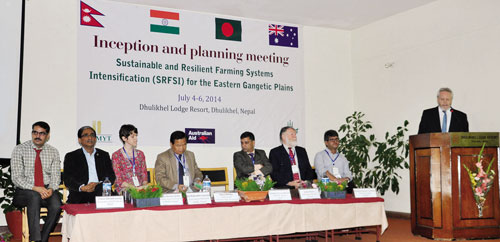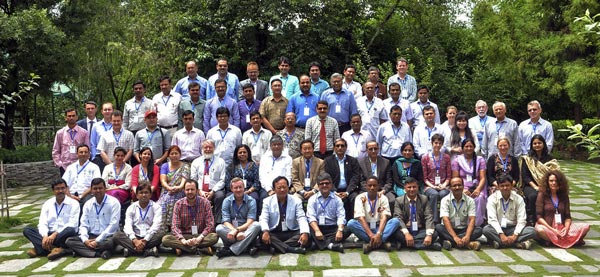By Mahesh Gathala, TP Tiwari, Pat Wall/CIMMYT
CIMMYT will lead a new research initiative to make agriculture more productive, profitable and sustainable for smallholder farmers in the Eastern Gangetic Plains (EGP) of Nepal, Bangladesh and India.
Launched in Dhulikhel, Nepal, on 4 July, the five-year US$6.8 million regional research initiative, Sustainable and Resilient Farming Systems Intensification in the Eastern Gangetic Plains (SRFSI), will tap the agricultural potential of the area and target 7,000 farmers to test and adopt appropriate new technology and farming approaches.
The program, funded by the Australian Centre for International Agricultural Research (ACIAR), will operate in eight districts: two in northwest Bangladesh, two in the eastern Terai of Nepal and two each in the Indian states of Bihar and West Bengal.
The three-day Inception and Planning Meeting that launched the program was attended by 84 participants from Australia, Bangladesh, India, Mexico and Nepal. SRFSI is managed by CIMMYT on behalf of multiple partners including the national research and extension systems of Bangladesh, India and Nepal, Indian and Australian universities, national and international nongovernmental organizations, the Commonwealth Scientific and Industrial Research Organisation of Australia and four CGIAR Centers (CIMMYT, the International Rice Research Institute, the International Food Policy Research Institute and the International Water Management Institute).
The project was officially initiated by the Australian Ambassador to Nepal, Glenn White, together with the Executive Director of the Nepal Agricultural Research Council (NARC), Dr. Dil Bahadur Gurung; the Joint Secretary of the Nepal Ministry of Agricultural Development, Dr. Rajendra Prasad Adhikari; Dr. Claire Glendenning of the Australian Department of Foreign Affair and Trade; and Dr. John Dixon, principal adviser for ACIAR.
“This initiative will help to raise agricultural productivity in a region which has the potential to become one of Asia’s great food bowls,” White told the gathering of scientists and development practitioners.
The EGP is home to some 300 million people, with the world’s highest concentration of rural poverty and a strong dependence on agriculture for food security and livelihoods. The region is dominated by small farms with many female farmers who have little access to credit, quality seeds, fertilizers, irrigation or formal extension services. They also have to contend with climate-related risks and extreme events such as floods, drought and cold snaps.
 “This program will allow farmers to test a range of innovations to help them boost food production, including conservation agriculture and efficient use of water resources, while strengthening their ability to adapt and link to markets and support services,” White said. “Our aim is to enable at least 130,000 farmers to adopt these technologies within the next 10 years.”
“This program will allow farmers to test a range of innovations to help them boost food production, including conservation agriculture and efficient use of water resources, while strengthening their ability to adapt and link to markets and support services,” White said. “Our aim is to enable at least 130,000 farmers to adopt these technologies within the next 10 years.”
Gurung and Adhikari lauded the long-term partnership between CIMMYT and Nepal, as well as the ACIAR support of this project, and assured that the Ministry will extend its full support.
Key Objectives of the SRFSI
The Eastern Gangetic Plains region has the potential to become a major contributor to South Asian regional food security, but rice and wheat productivity remain low and diversification is limited because of poorly developed markets, sparse agricultural knowledge and service networks, and inadequate development of available water resources and sustainable production practices. Labor shortages – mainly during sowing and harvesting – are becoming more acute. These factors lead to smallholder vulnerability to climate and market risks that limit investments in new technologies.
SRFSI will undertake several high-priority activities to reduce these factors:
• Improving farmers’ access to inputs, services and market information in order to reduce the risk associated with adopting new practices.
• Removing policy barriers to technology adoption.
• Analyzing the appropriateness of technologies, service provider models, markets and policies for women farmers, and adjusting them where necessary, to help ensure food security and gender equity in the region.
• Developing new knowledge among farmers, researchers, extension and change agents, service providers, agro-dealers and others involved in agriculture. This has been identified as the key to achieving widespread adoption of new technologies and reductions in poverty in the EGP.
• Investing heavily in capacity building at multiple levels, from field days to short courses to linkages with advanced research institutions. Ultimately the project focal communities, where all aspects of the project activities are put into place to achieve the desired change, will become demonstration or learning sites for institutions or individuals interested in agricultural development, where they can observe the technological changes and talk with farmers and farmer organizations about the importance of the different components of the project in bringing about agriculture change.
 Climate adaptation and mitigation
Climate adaptation and mitigation 
